Motion Sensors
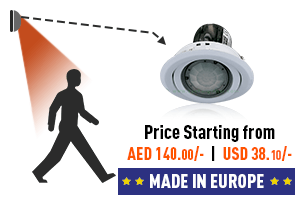 We are supplying a huge variety of motion sensors for numerous residential and commercial applications. These come in innumerable types and shapes by different manufacturers. Hence we provide extensive assistance for customers in the selection process.
We are supplying a huge variety of motion sensors for numerous residential and commercial applications. These come in innumerable types and shapes by different manufacturers. Hence we provide extensive assistance for customers in the selection process.
Motion sensors and Motion detectors
Motion sensors are the most widely used category of automation sensors and is equally utilised in industrial and commercial
applications. The reason for wide usage is that these are the essential part of energy conservation in commercial, residential and industrial applications and the installation is extremely simple enough to be carried out by normal technicians. These are also known as movement sensors and movement detectors.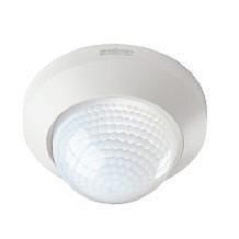
Such sensors are also an integral part of Home automation and office automation systems which can be integrated into an entire system or individual units or a section of the room, corridor etc. as per the customer requirements. These are available in the latest Automation protocols such as KNX, Bacnet etc. for integrating into an entire building management system. Ultrasonic sensors and Infrared sensors
are the most commonly used technology for detecting motion.
Operating principle of Motion Sensors technology
As obvious from the name, these are also known as motion detectors are used to detect motion. The motion thus detected may be that of human beings, machinery parts, mechanical parts etc. depending on the application. The basic principle is that it will be constantly monitoring a certain area or a linear path. If any movement happens in this area, the sensor will detect the same and an output signal will be provided to other connected circuitries and instruments to carry out any related functions. These are also called motion sensor switch since the sensor is only carrying out a switching action. Different models for indoor and outdoor applications are available.
How do motion sensors work?
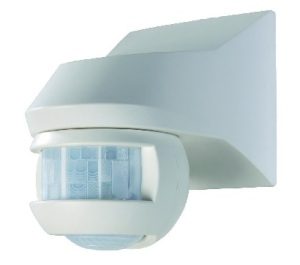
All motion sensors work by detecting an input and providing an output. Motion detectors use different technologies for detecting motion. All such sensors have a transmitter and receiver. The transmitter constantly emits different types of waves based on the technology used and the waves are received back at the sensor after a time delay. Various parameters between transmission and reception are analysed by the motion detector which determines whether a motion has been detected.
All of them will generally have adjustable sensitivity and delay timing. The sensitivity setting is for adjusting the sensitivity of movement detection. If the most sensitive setting is selected, minute movements will be detected. Delay timing is adjusted to set the delay in switching after a movement stops. Eg. if a delay period of 60 seconds is programmed for the motion sensor, the lights will be switched off after 60 seconds from the last detection of motion. These particular types are also called motion sensor lights.
Few of the major technologies utilised are briefed below.
A common type of Motion Sensor
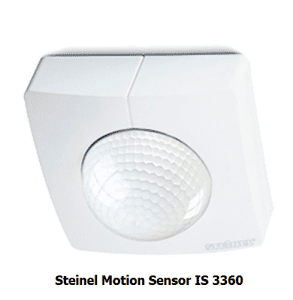 Please see details of one of the commonly used motion sensor by Steinel®, model no. IS 3360
Please see details of one of the commonly used motion sensor by Steinel®, model no. IS 3360
This is a general-purpose indoor/outdoor motion sensor with an IP54 protection rating.
Technical details:
- Dimensions : 95 mm (H) x 95mm (W) x 65 mm (D)
- Power supply: 230-240V, 50 Hz
- Usage: Indoor and outdoor
- Mounting type: Ceiling
- Installation height: 2.5 m to 4.0 meter
- Output connectivity (resistive load) : 2000 W
- Time delay setting: 5 seconds to 15 minutes
- Sensor type: Passive Infrared motion sensor
IR Sensors (Infrared sensor) or PIR Sensor (Passive Infrared Sensor)
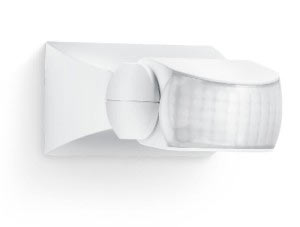
Infrared sensors are commonly known as IR sensors which utilise Infrared rays for sensing motion. The infrared rays are constantly transmitted by the transmitter which bounces back at the stationary and moving objects and reaches the transmitter. The transmitter and receiver of the IR sensors can be on the same device or in separate devices. eg. An IR sensor used to prevent a rolling shutter of a gate when a person is standing at the door may utilise a separate transmitter and receiver at opposite ends. When the shutter is in open condition, the transmitter will start emitting infrared rays from one end of the door to the opposite door where a receiver is installed which is an IR sensor. If a person walks through the doors the Infrared rays are obstructed which is detected by the receiver and hence will prevent the shutter from closing. Such simple applications can be carried out using IR sensors which are very cost-effective.
Motion sensor light
One of the most common applications of the motion sensor is a motion sensor combined with a light called as a motion sensor light. The term motion sensor light is generally referred to when the light also is combined as a single unit. The advantage is that the customer does not need to identify the lighting circuit and connect the sensor separately. The motion sensor light can be simply connected to a power circuit and it will start working.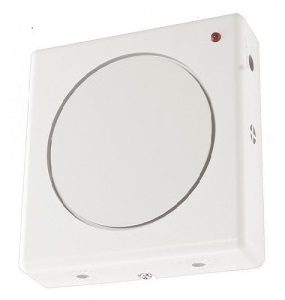
The next variant of motion sensor light is a light combined with a motion sensor and also with a light sensor. These two sensors are combined to activate either the inbuilt light. The light level can be adjusted so that the light will work only when it is dark and when motion is detected in its vicinity. Both the conditions have to be true so that the light will be switched ON automatically.
Ultrasonic motion sensor
Ultrasonic sensors work with the same principle as that of IR sensors regarding transmission and receiving. However, the waves emitted are high-frequency sound waves known as ultrasonic waves which are not audible for human beings. The ultrasonic sensors are more sensitive than infrared sensors in detecting motion. As available in numerous models, sensitivity can be adjusted to suit the requirement of the operating area.
A major difference is that ultrasonic sensors detect movement across glass walls or doors. A typical application of such a sensor will be in a classroom where students are expected to generate only mild movements.
Also, there are dual sensors which combine ultrasonic sensors along with IR sensors.
Example of a simple application of Motion detector
As a simple example, we will consider a corridor of an apartment complex which is normally unoccupied. The lights of the corridor will be continuously in switched-on condition normally operated through a manual switch resulting in huge energy wastage. Motion sensors can be installed at every 20 meters (this will vary depending on the model to be used, distances and corners to be covered etc.) which we can call as the range of vicinity of this sensor. The motion detector has an output to which all the lights of the corridor are connected in series. Hence the sensor acts as a normal electric switch which is in OFF condition if there is no movement in the corridor. If any movement is detected, the switch is turned ON, and the connected lights are automatically switched ON. The lights will be normally in off condition and when someone comes out of a lift or a room, a movement is detected and the lights are switched ON by the motion detector. However, it has to be understood that after a certain distance if the person stands idle in the middle of the corridor, the lights will be automatically turned off since there is no movement detected.
Most common applications of a motion sensor, IR sensor and Ultrasonic sensor
Most common installations are for energy conservation for Hotels, Restaurants, Villas, Office etc. and for motion detected alarms for home security.
Applications for energy conservation
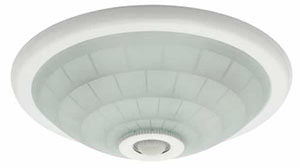
For this application motion detector simply turns off electrical circuits when no one is in the range.
Hotels – Corridors, Bathrooms, Lifts, Staircases etc. where the lights will operate only if people are present. Restaurants -Bath Rooms where the lights and exhaust fans will operate only if people are present Villas – Various Rooms, Bathroom, Kitchen etc. where automated controls are given for convenience and energy Saving Office – Bathroom, Kitchen, Entire office etc where automated controls are given for convenience and energy Saving for controlling lights, Air conditioning, Heating and Ventilation (HVAC) system etc.
Motion sensor with alarms for intruder detection
Another common application is the detection of an intruder inside a villa, sensitive areas etc. for home security. The detection and activation principle is same as all other explanations as above. Instead of controlling a lighting circuit, upon detection of motion in the area, it will activate a local alarm or siren thus creating an alert. The detector and the alarm can have power supplies from an independent battery so that the whole system will work even in the case of power failure. Many standalone models are available which can be simply installed without altering any of the existing electrical wiring systems. Wireless systems also are available which are extremely simple for installation
How to select motion sensors or motion sensor lights
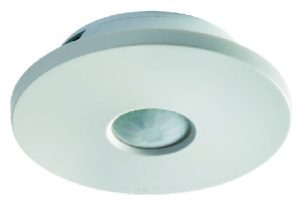
For proper selection, please go through the following criteria.
Is the installation required for indoor or outdoor applications? For outdoor applications, the ingress protection (IP protection rating) will be higher such as IP 67.
Length, width and height of the area. These details are required to select suitable models. For any manufacturer, there will be different models with coverage distance such as 20 ft, 40 ft etc.
What are the connected electrical loads to be controlled such as Air conditioner, normal lights, LED lights, fluorescent lights etc?
Whether you need ultrasonic sensors or Infrared sensors?
What is the nature of movements in the area? If there are too few people and only minute movements are expected, it may be better to use presence or occupancy sensors. Please see our separate pages for the same.
Commonly used terminology for motion sensors
Being one of the most commonly used and simple sensors, these are known under various terms such as:
- motion detector
- motion detecting sensor
- motion detection sensor
- motion detector light
- movement sensor
- movement detector
- movement detecting sensor
- motion sensor
- light motion sensor
- motion sensor light
In principle, all of the above are some devices called in different terms.
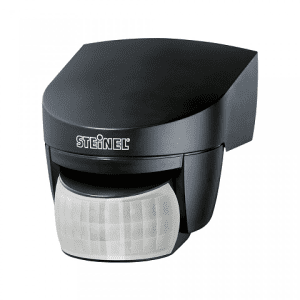
Few models of Steinel® make Motion Sensors:
-
Infrared motion detector IS 140-2
Dimensions (h x w x d) : 70 x 86 x 95 mm
Power connection : 230-240 V/50 Hz
Sensor type : Passive infrared
Application : indoors and outdoors
Installation : Wall
Max. output (resistive load, incandescent lamp) : 1000 W
Output (uncorrected, inductive, cos φ = 0.5, e.g. fluorescent lamps) : 500 VA
Max. output (electronic ballasts, capacitive, e.g. low-energy lamps) :6 ea. max., C ? 132 µF -
Indoor Motion Sensor Light RS 100 L
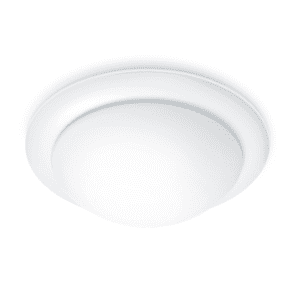
Indoor motion Sensor Light RS100L Dimensions (h x w x d): 310 mm dia. x 125 mm
Power connection: 230-240 V/50 Hz
Sensor type : High Frequency
transmitter power : approx. 1 mW
HF-system : 5.8 GHz
Output: 100 W max. / E 27
Additional switching capacity at L´: (resistive load, e.g. bathroom / WC extractor fan) 800 W max.
Detection angle : 360° with 160° angle of aperture -
Infrared motion detector IS 345 MX Highbay
Dimensions (h x w x d): 95 x 95 x 65.5 mm
Power connection : 230 – 240 V / 50 Hz (2.5 mm² max.)
Sensor type : Passive infrared
Application : indoors and outdoors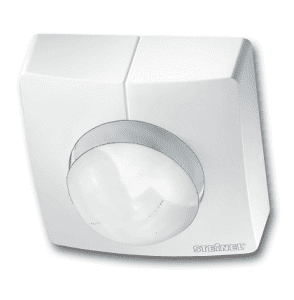
Motion detector IS345MX High Bay Installation : Ceiling, Corridor
Recommended installation height : 4.00-12.00 m
Max. output (resistive load, incandescent lamp) : 2000 W
Output (uncorrected, inductive, cos φ = 0.5, e.g. fluorescent lamps) : 1000 VA
Max. output (series-corrected): 900 W
Product Description of Motion Sensor model VAC-TMT7512
- Brief Title of the device: PIR 360 Degree Ceiling Mount Microwave Motion Sensor.
- Brief Description of the device: This is a microwave-based motion sensor for all types of indoor applications. It can work on 110V. 220V AC or with DC voltages. This motion sensor can operate within a range of 15 meters. You may use it in corridors, staircases, offices, toilets, balcony, garage etc.
- Model number: VAC-TMT7512
- Brand: VackerGlobal
- Seller: VackerGlobal
- SKU Number: 1009000268
- Price (AED): 78.00
- Price Validity: 31 December 2020
Vacker Group is a major motion sensor supplier in entire United Arab Emirates covering Dubai, Abudhabi, Sharjah, Ras Al-Khaimah, Alain, Ajman UAE. Also, we supply motion sensors in other Middle East countries including Oman, Qatar, Bahrain, Kingdom of Saudi Arabia & Bahrain for all type of commercial and residential applications.
